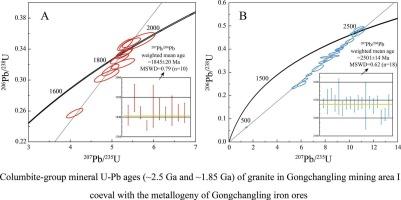与华北克拉通公长岭铁矿成矿同时发生的两次铌钽矿化事件:来自铌矿群矿物年代学的约束
IF 3.6
2区 地球科学
Q1 GEOLOGY
引用次数: 0
摘要
弓长岭铁矿以高品位磁铁矿丰富而闻名,由于弓长岭矿区的高品位铁矿体积较大,故研究多集中在弓长岭矿区Ⅱ。本研究对弓长岭矿区上壁花岗岩中柱状矿群矿物进行了U-Pb定年Ⅰ,得到了2501±14 Ma和1845±20 Ma两个年龄。两个年龄的柱状岩群矿物化学成分均以Nb >; Ta、Fe >; Mn、较低的U/Th和相对富集的HREEN含量为特征,考虑到区域性的~ 1.85 Ga单矿物和多矿物铀成矿作用,稀有金属成矿应为nyf型。~ 2.50 Ga成矿作用与李家堡子伟晶岩铌钽矿床同期形成,表明辽东地区新太古代晚期具有极好的区域性铌钽成矿潜力;~ 1.85 Ga的铌钽矿化事件表明,近期应关注胶辽基带和跨华北造山带内广泛存在的古元古代岩体。这种密切的时空关系表明,弓长岭矿床中古元古代铌钽矿化与高品位铁矿可能是同一地质过程的产物,为两种矿床类型的成矿过程提供了重要的认识。本文章由计算机程序翻译,如有差异,请以英文原文为准。

Two Nb-Ta mineralization events coeval with the metallogeny of Gongchangling iron ores in the North China Craton: Constraints from geochronology of the columbite-group minerals
Gongchangling iron deposit is famous for its large amount of high-grade magnetite ore, thus most of the researches focused on Gongchangling mining area Ⅱ due to the bulky high-grade iron ore. In this study, the U-Pb dating of the columbite-group minerals from the hanging wall granite in Gongchangling mining area Ⅰ yields two ages, i.e., 2501 ± 14 Ma and 1845 ± 20 Ma. The chemical compositions of the columbite-group minerals of both ages are always characterized by Nb > Ta, Fe > Mn, low U/Th, and relatively enriched HREEN content, in consideration of the regionally ∼1.85 Ga mono- and multi-mineral uranium mineralization, the rare metal mineralization should be of NYF-type. The ∼2.50 Ga mineralization is coeval with the Lijiapuzi pegmatite Nb-Ta deposit, indicative of the excellent regional late Neoarchean Nb-Ta mineralization potential in eastern Liaoning Province; the ∼1.85 Ga event of Nb-Ta mineralization suggests that the widespread Paleoproterozoic plutons within Jiao-Liao-Ji belt and Trans-North China Orogen should be concerned in the near future. The intimate spatiotemporal relationship implies that the Paleoproterozoic Nb-Ta mineralization and the high-grade iron ores in the Gongchangling deposits were probably the products of the same geologic process, providing critical insights into the ore-forming process of both deposit types.
求助全文
通过发布文献求助,成功后即可免费获取论文全文。
去求助
来源期刊

Ore Geology Reviews
地学-地质学
CiteScore
6.50
自引率
27.30%
发文量
546
审稿时长
22.9 weeks
期刊介绍:
Ore Geology Reviews aims to familiarize all earth scientists with recent advances in a number of interconnected disciplines related to the study of, and search for, ore deposits. The reviews range from brief to longer contributions, but the journal preferentially publishes manuscripts that fill the niche between the commonly shorter journal articles and the comprehensive book coverages, and thus has a special appeal to many authors and readers.
 求助内容:
求助内容: 应助结果提醒方式:
应助结果提醒方式:


